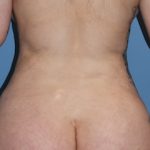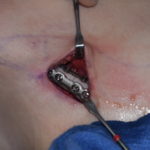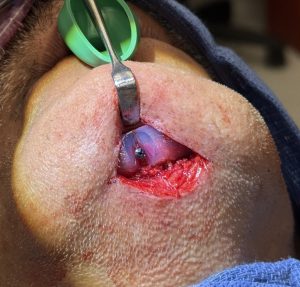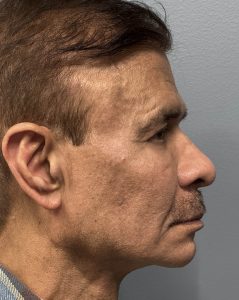Background: Chin implants are the original form of aesthetic facial augmentation. Their design has always been primarily for horizontal augmentation with variable amounts of width increases built into different implant styles. While some patients have been recognized as needing some vertical height increases as well surgeons have typically used these horizontally projecting implants in a tilted or downward fashion to do so…often not very successfully. While these positioning maneuvers can be useful for very small vertical increases this is not their intended use.
The vertical lengthening chin (VLC) implant is designed to fill that infrequent role of when a truly short lower third of the face exists. In the short lower third of the face the vertical deficiency can exists in isolation or be associated with a horizontal projection deficiency as well. If it is only a vertical deficiency a VLC implant can be used if the length needed is 7mms or less. This requires that the chin implant is positioned with a purely vertical inclination. If it is a combined vertical and horizontal chin deficiency then the VLC implant can be used as it is optimally designed…at a downward angulation from the chin bone. Rather than getting its maximal projection from the pogonion it is centered over agnation the low point of the midline of the chin.
Besides understanding the dimensional role of the VLC it is also important do you understand the influence of it size. Because the soft tissue chin pad must be elevated off of the bone for implant placement, once placed, the soft tissue chin pad must be capable of being pulled over it. This soft tissue requirement poses some limitation’s for implant size. As a general rule the combined horizontal and vertical implant augmentation should usually not exceed the 12 mm. There may be room for increases over this number if the patient has had a prior chin implant which always provides some soft tissue expansion. Otherwise larger dimensional changes of chin projection will require a bony genioplasty which is not limited by this soft tissue chin pad issue.
Case Study: This older male had a chin implant placed 42 years previously through a submental incision. It provided minimal improvement in his chin size. The style of chin implant and it’s size were unknown. By looking at his chin today in both the front and profile views a significant horizontal and vertical deficiency could be seen. The lower third of his face was very disproportionate to the upper two thirds.
Under sedation anesthesia his previous submental scar was opened and dissection carried down to the chin bone. The chin implant capsule was opened and immediately silicone gel came oozing out. It was immediately obvious that this was a very old style small silicone gel chin implant. The implant was removed and it could be seen to be ruptured. The projection that it provided was measured to be 5 mm and was an old button style with imited central projection.
The implant capsule was completely removed and subperiosteal dissection carried out for a much larger implant footprint. A medium vertical lengthening chin implant was selected and by comparison it could be seen that this will be a major change in all three dimensions.
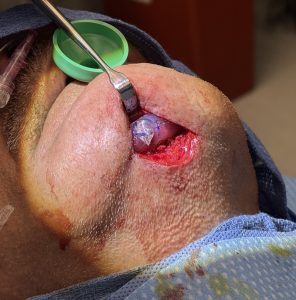

The VLC implant is an infrequently used method of chin augmentation. This is partially because the combined horizontal and vertical chin deficiency is under diagnosed and the need for it is limited as most chin deficiencies are horizontally based. But in the properly selected patient it is best implant options short of a custom made chin implant.
Key Points
1) The three-dimensional short chin is associated with a short lower third of the face.
2) The preformed vertical lengthening chin implant creates a combined horizontal and vertical increase in chin projection.
3) Screw fixation is essential to maintain the vertical lengthening chin implant in proper position.
Dr. Barry Eppley
World-Renowned Plastic Surgeon

